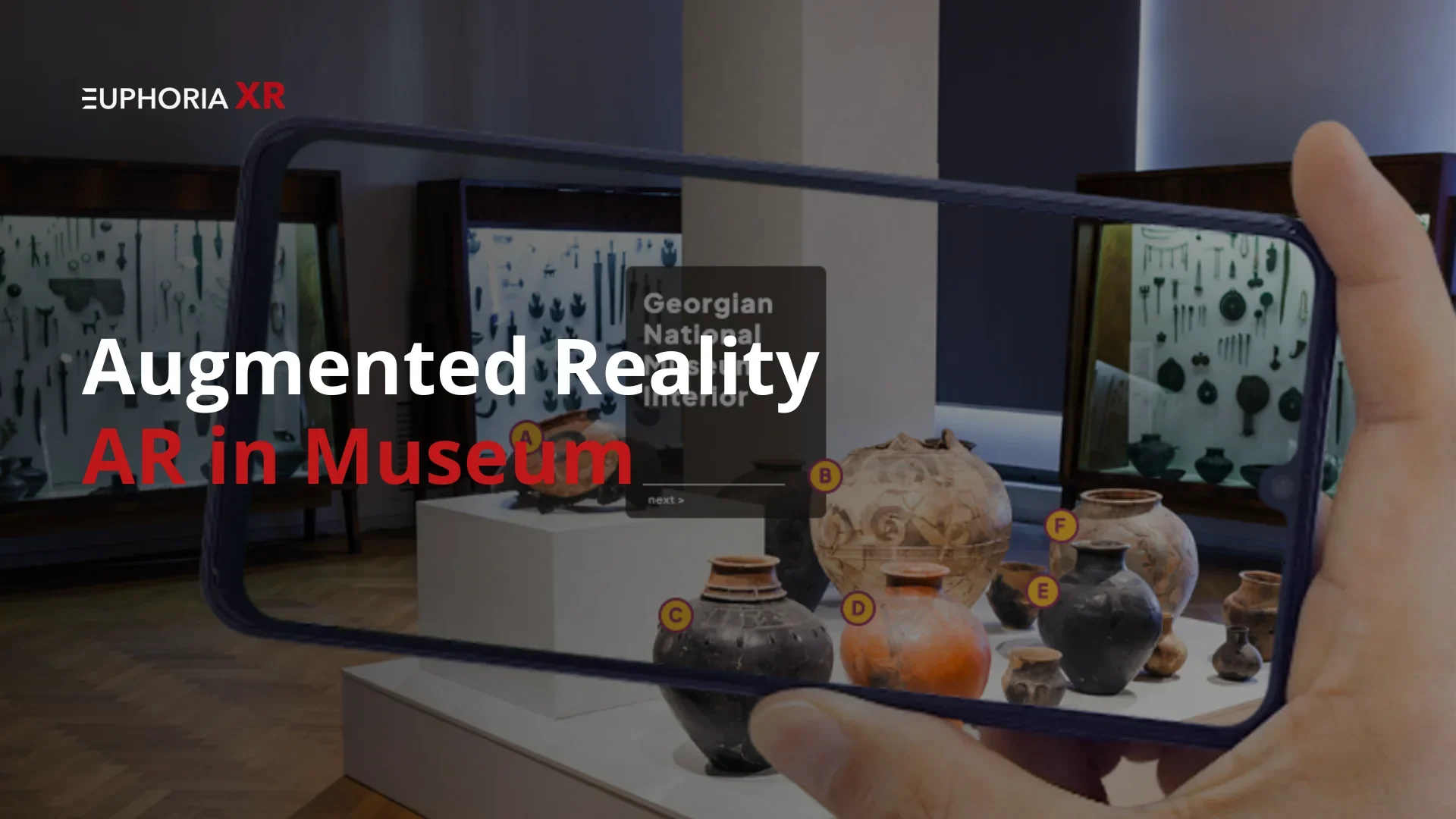Have you ever felt like going to the museum is… well, a little passive?
You trip through row after row of glass-covered display cases, running your eye over little text plaques, squinting at artifacts through slivers of glass, and trying to think what it was like to live the life behind the stuff. That is interesting, but at the same time, it can be rather dry, especially for kids or first-time visitors. History and art seem like magic, but they often seem claustrophobic behind walls.
That is what is happening in many museums now: how to keep the people interested in a world where everybody has got a short attention span, and all the experience is in the digital world.
Then just consider going to a museum and pointing your phone at a painting, and all of a sudden the characters start to move, an artist comes out explaining the story, and then a 3D model is used and you see how it was created. Now you process not only by looking you are also interacting. This is what AR in Museums offers.
It is not just something futuristic. It is being done today, in schools and universities all over the world, which are realizing the possibilities of Augmented Reality (AR) to make history, science, and creativity come to life in a new way altogether.
Get to know how we assisted Virginia Beach and how we can assist you. Make a reservation to experience AR and consult on any issue.
The Evolution of Museum Storytelling
There are times you used to go to a museum and silently read something behind a glass and look at a still exhibit. In those days, it was easy to tell the story, facts on a plaque, objects in a case, and possibly an audio guide.
However, the visitors now have higher demands. They not only demand to watch history, but they also want to experience it. They have the desire to be in the shoes of those people in the past and experience their surroundings and listen to them talk. In particular, especially by the younger generations, the definition of engagement entails interactivity, affectivity, and immersion.
The transition has provoked a revolution in the storytelling of the museums. And in the center of this transformation lies the Augmented Reality (AR). It is a technology that is transforming the role of observation into investigation. The museum, with the entire use of AR features, becomes not just the place to learn something new, but rather an arena in which the past unfolds around you. Be it a battle in the virtual world or listening to the artist talk about his or her creation, or simply observing how the historic home restructures itself in front of you, with AR, history cannot be neglected.
How Museums Are Using Augmented Reality
AR (Augmented Reality) is shaking up the museum world-wide, and it is transforming education.
This is the way they are using it:
Astronomical Comets: Bringing history back to life
In history museums, tourists can use their phone to scan a statue or an artifact and watch it come to life, either moving, speaking, or appearing as it was centuries ago.
Larger narratives with more meaning
On AR, you will add videos, audio, and fun facts that cannot be shown on small wall labels. To scan a painting, you will have an opportunity to listen to the story of a painter or see the process of its creation.
Assisting kids to be involved
The reality is that children like screens. AR allows them to participate in digital treasure hunts or play with animated characters at exhibitions.
Increasing marginal displays
Not all museums are very spacious. AR allows them to display more 3D objects without using additional space.
Getting learning more individualized
In some museums, you can use the AR app to decide what you want to focus on, such as fashion, food, or ancient tools, so the experience can be just right for you.
Emerging fossils, to the renowned sample artwork, in museums having AR are now letting people appreciate and easily relate (and a lot more fun) to their cultures, science, or stories of the past.
AR enables museums to display exhibits with animations, sound, and 3D layers to learn, interact, and experience museums in all-new ways.
Want to make museums immersive? Collaborate with an Augmented Reality Development Company and bring your ideas to life.
Key Use Cases of AR in Museums
Reanimating Lost or Fragile Artifacts
The museum objects are not homogeneous; some of them are too old, too fragile, or too broken to be demonstrated completely. AR will allow the visitors to see what these items were like when they were new or even how they were used. As an example, a broken vase can be displayed through AR to be as good as new, or a skeleton moving as it used to move thousands of years ago.
AR assists the museums in restoring and making their broken or missing artifacts come to life with the aim of education.
Interactive Storytelling and Learning
AR allows you to listen to the story, see videos, or even follow animated figures that give details on what you are looking at because you are not supposed to read long text labels. This enhances learning, which is more enjoyable to the kids and first-timers.
AR is transformed into an interactive experience by using museum exhibits in video, voice, and animation.
Expanding Exhibit Space with Virtual Layers
Not all things can fit in many museums. AR will provide additional information (such as concealed details, artist commentaries, or background information) in the absence of the use of additional space. It is to assign the item its digital drawer of extras.
By using AR, the museums can display more content without using space in a physical area.
Immersive Experiences Inside the Artwork
AR will allow visitors to walk inside a painting or a historical painting and gaze around. Think about walking around and scanning a wall and being surrounded by a battlefield, a royal garden, or an artist’s studio, and you are standing right there.
AR will allow those visiting a museum to walk in and experience artworks in a 360-degree immersive manner.
Location-Based Historical Reconstructions
It is also possible to bring back to memory, with the help of AR, what a certain place or a building was prior, directly on the same location. You might be facing the ruins, and before your own eyes, you can view what the temple or castle that hid underneath the ruins had looked like when in its exact position.
AR in museums is applicable in creating past places in real time, where the GPS and site triggers are used to recreate historic places to recreate.
Real-Life Examples of Notable Museums Using AR
The use of AR in museums is a very popular phenomenon, and there are many examples of its use. Some major museums are offering improved visitor journeys with the enhancement of Augmented Reality (AR) around the world to make the journey more inclusive, educational, and emotive. Those are some of the most prestigious institutions reinventing cultural exploration employing AR:
Art Gallery of Ontario, Toronto
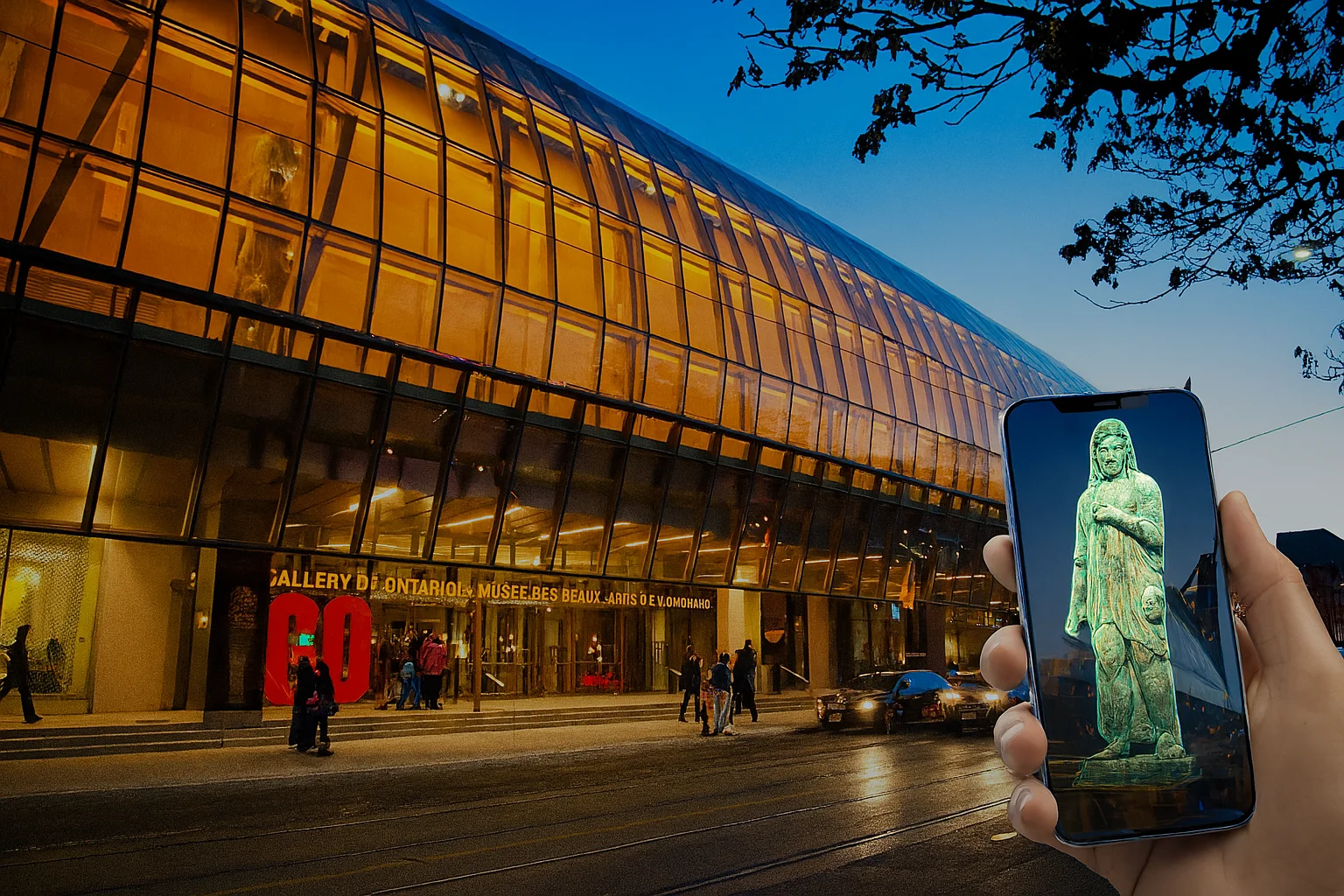
Innovation meets nostalgia as this gallery employs AR to introduce and overlay interactive layers to old works of art, adding interpretation of the artist behind the art, process of creation, as well as obscurities that enhance usability of knowledge in real time.
The Smithsonian Institution, Washington, D.C.
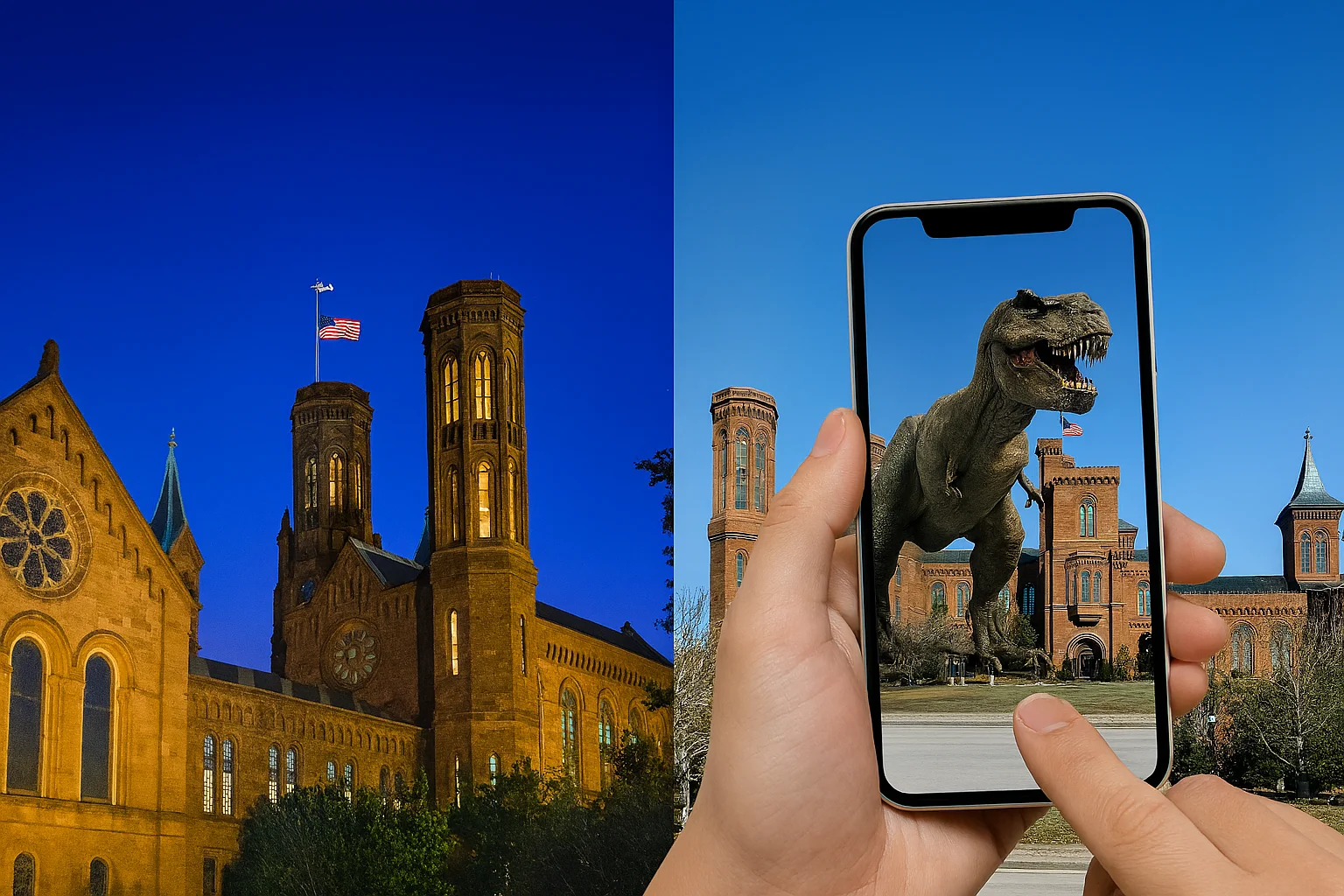
The first to understand the potential of AR in museums, the Smithsonian provides AR animations of ancient fossils, historical relics, and the scientific findings that revive the world of dinosaurs and bring a new experience of learning not only to the kids but also to the adults.
Asian Art Museum, San Francisco
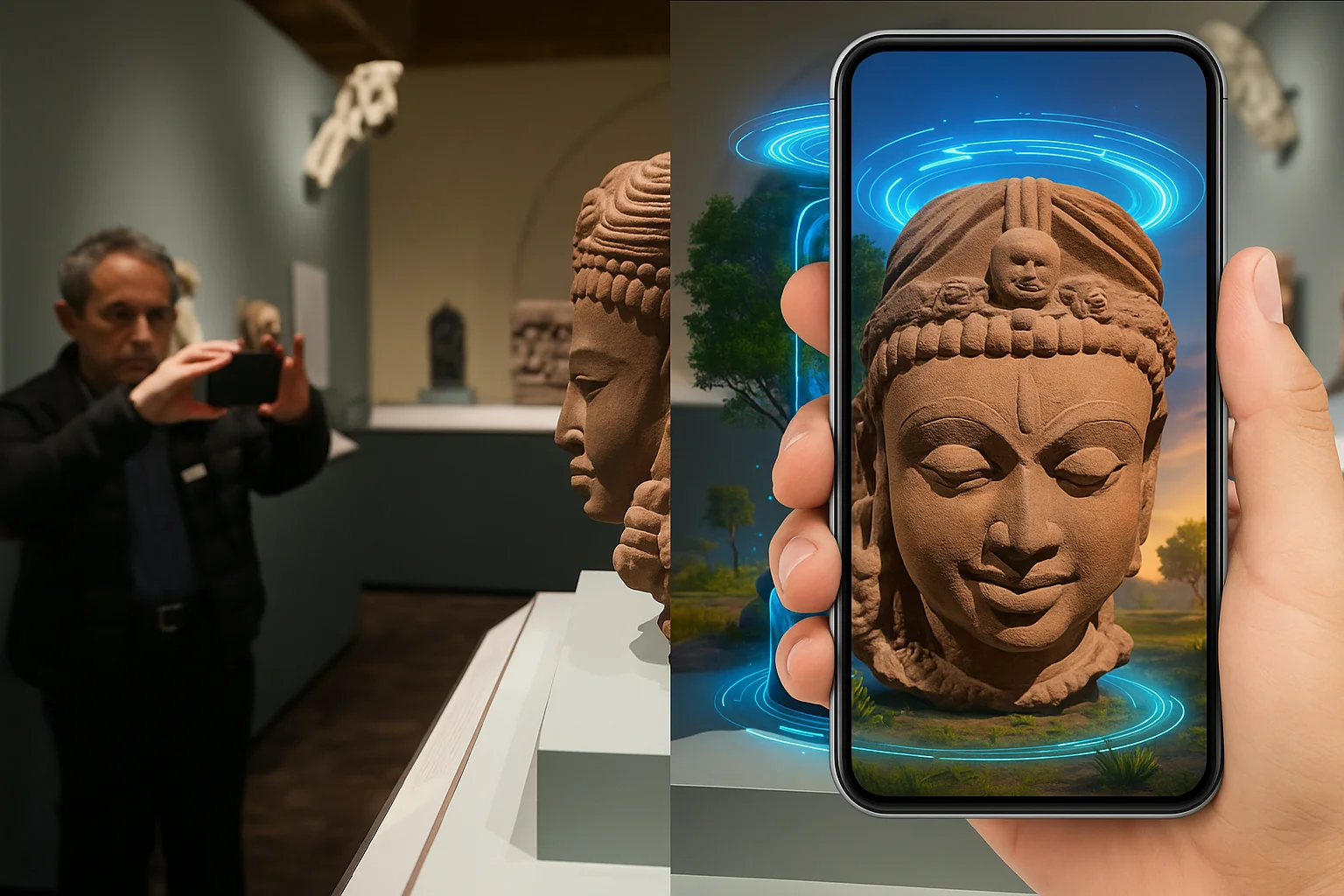
This museum converts old arts of East Asia into travel adventures. Instead, visitors will be able to dwell on symbolic elements, cultural practices, and mythological tales through and within the piece, crafting a rich experience with the narrative.
The National Gallery, London
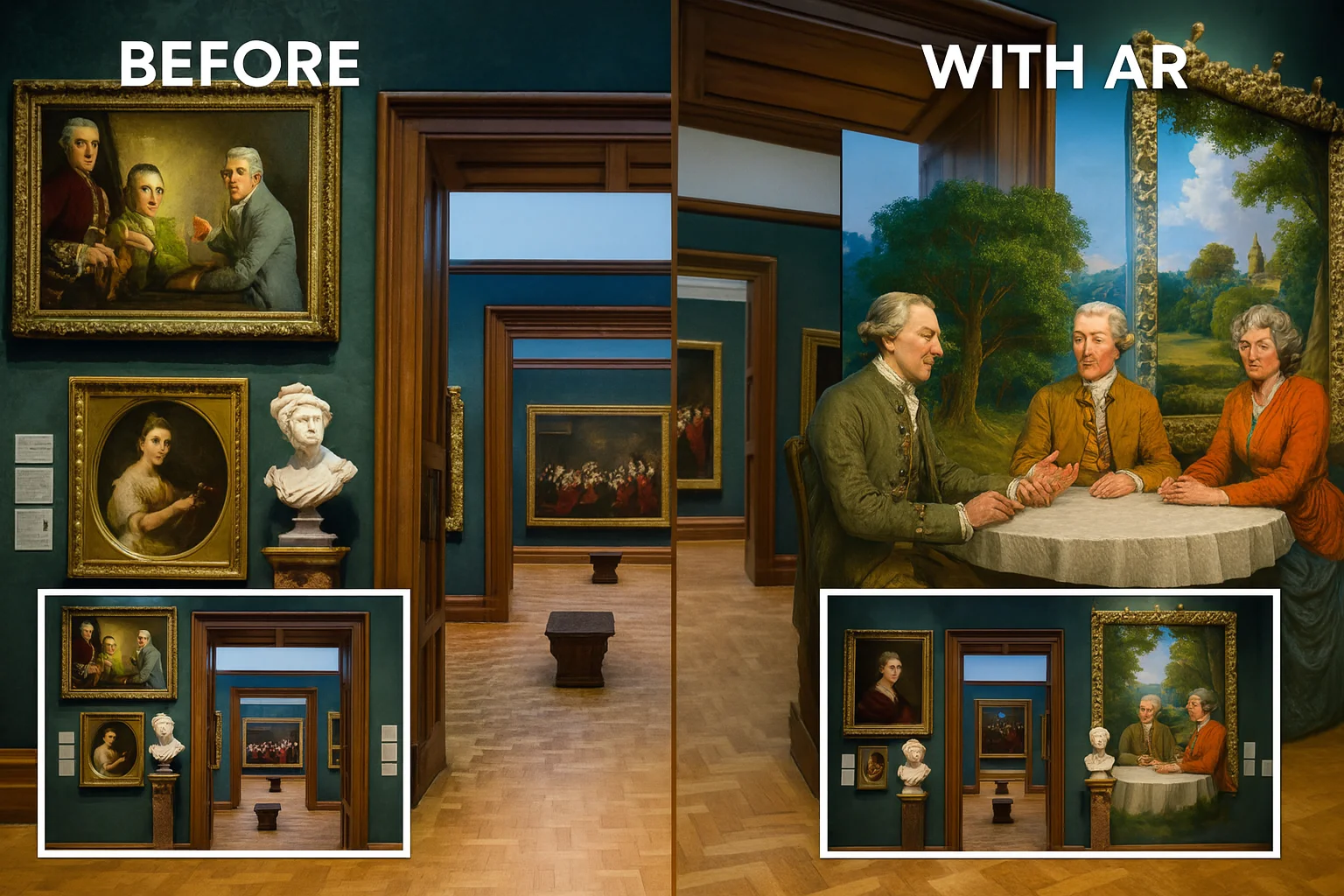
Paying attention to access and education, the National Gallery elaborates on the use of AR in order to make classical art more appealing to young visitors. Gameplay features in storytelling enable children to get familiar with historic paintings in a fun, unforgettable manner.
The National Museum of Singapore
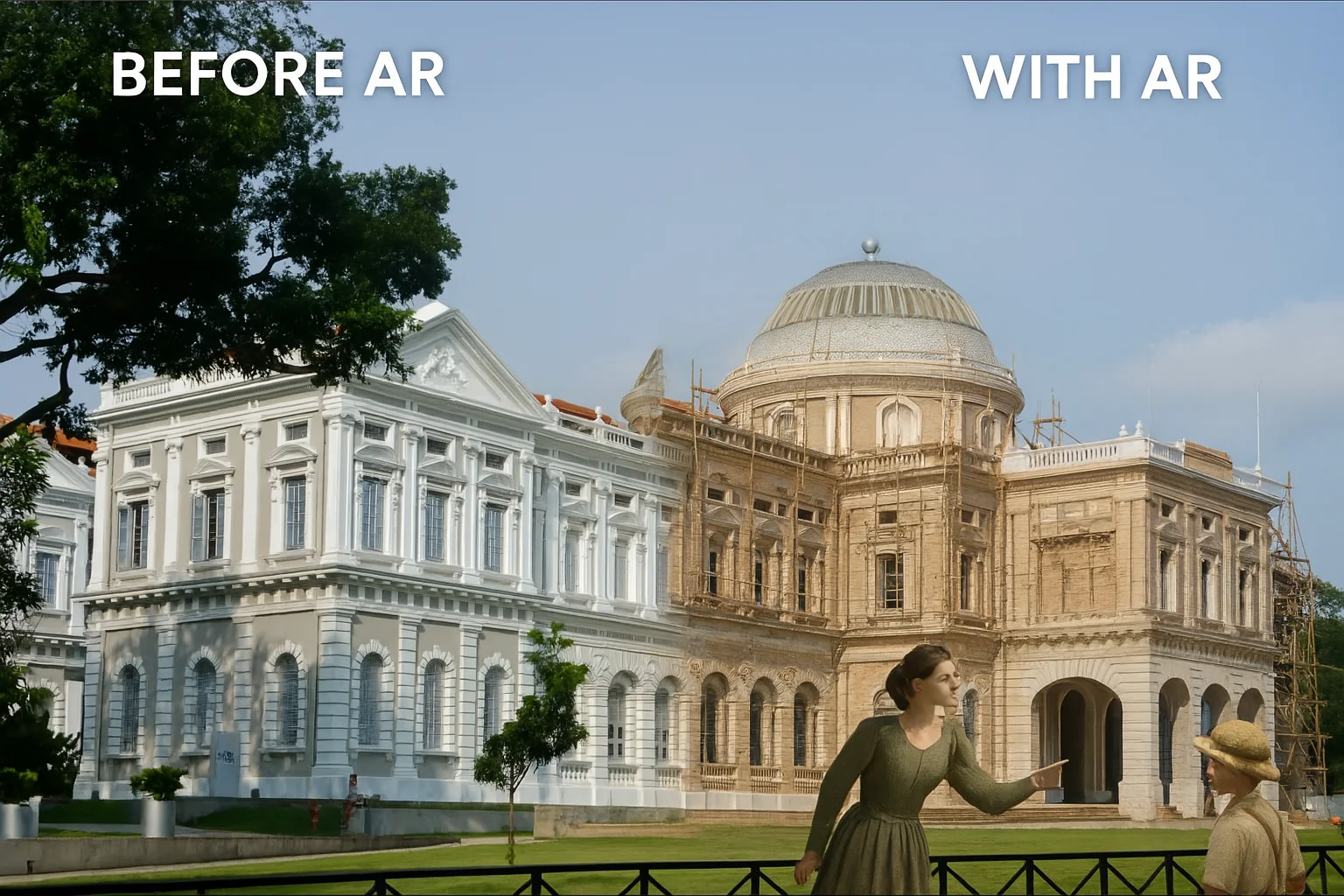
One of the leaders in the sphere of digital innovation, this museum allows the reconstruction of lost objects, shows forgotten narratives, and visualizes the changing landscape of cultures in Singapore, bringing the past and the present together in a visually attractive way.
The Kennedy Space Centre, Merritt Island
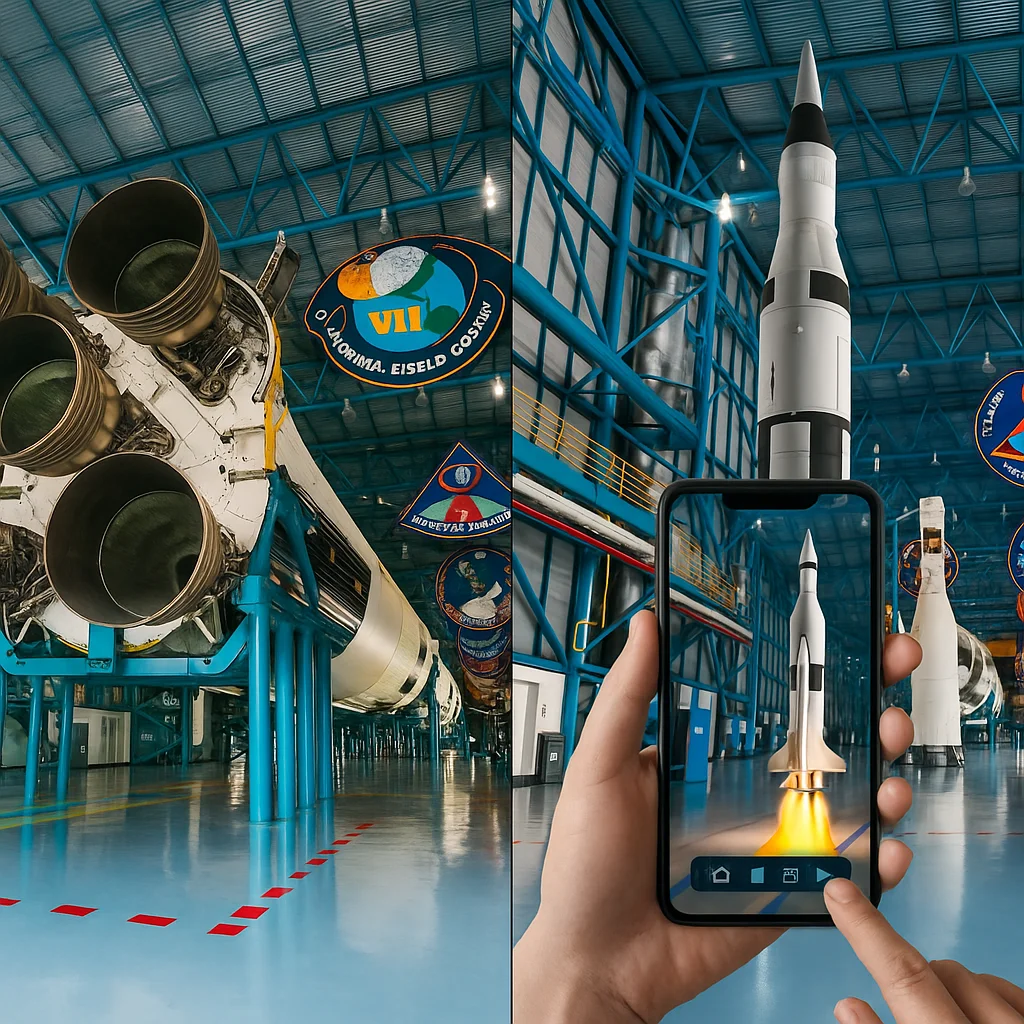
AR is taking space education to the next level. The tourists are allowed to make a simulated lunar mission, visit the interiors of rockets, go through the stages of the liftoff, and aerospace history becomes close and real here, even on Earth.
Pérez Art Museum, Miami AR Experience
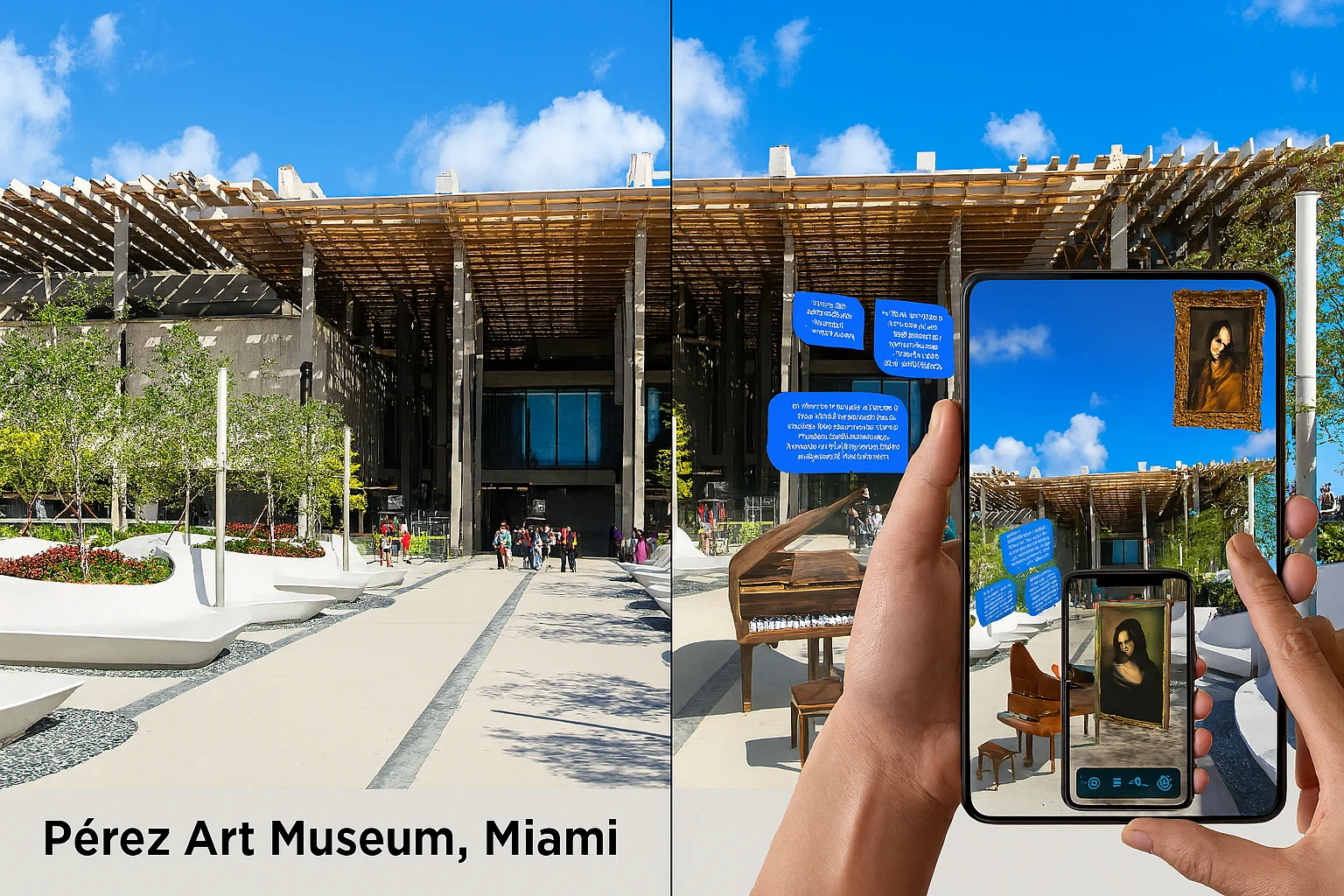
A modern art institution that includes AR in its work, this museum uses it to make the installations sound, move, and tell stories interactively, offering people to see more modern art than a canvas.
AR Experience in Muséum National d’Histoire Naturelle, Paris
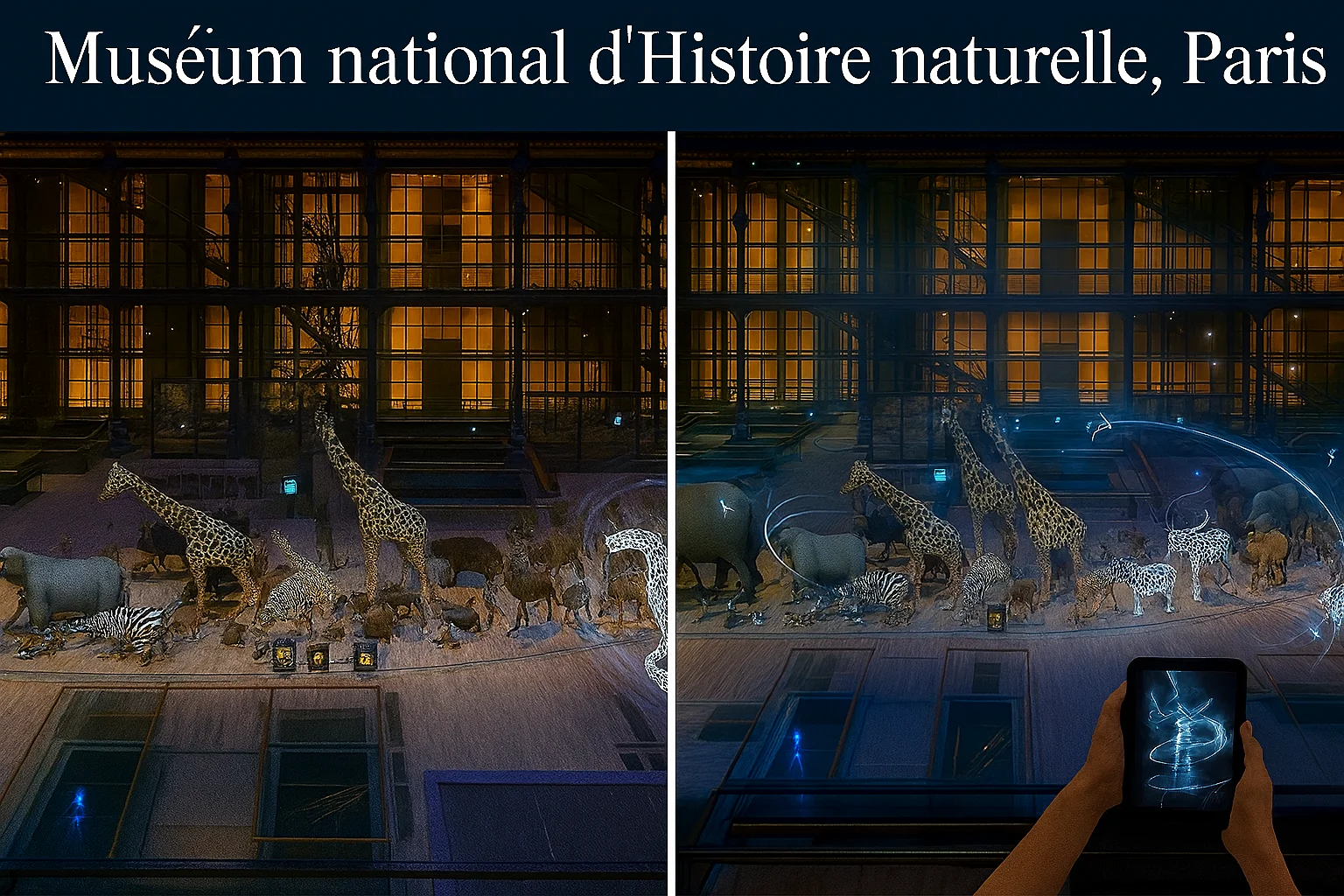
AR brings the natural history exhibit alive by allowing extinct creatures to be recreated, recreated environments, and depicting events of evolution as illustrated through animation, allowing the visitor to see the scientific past in motion.
De Young Museum, San Francisco
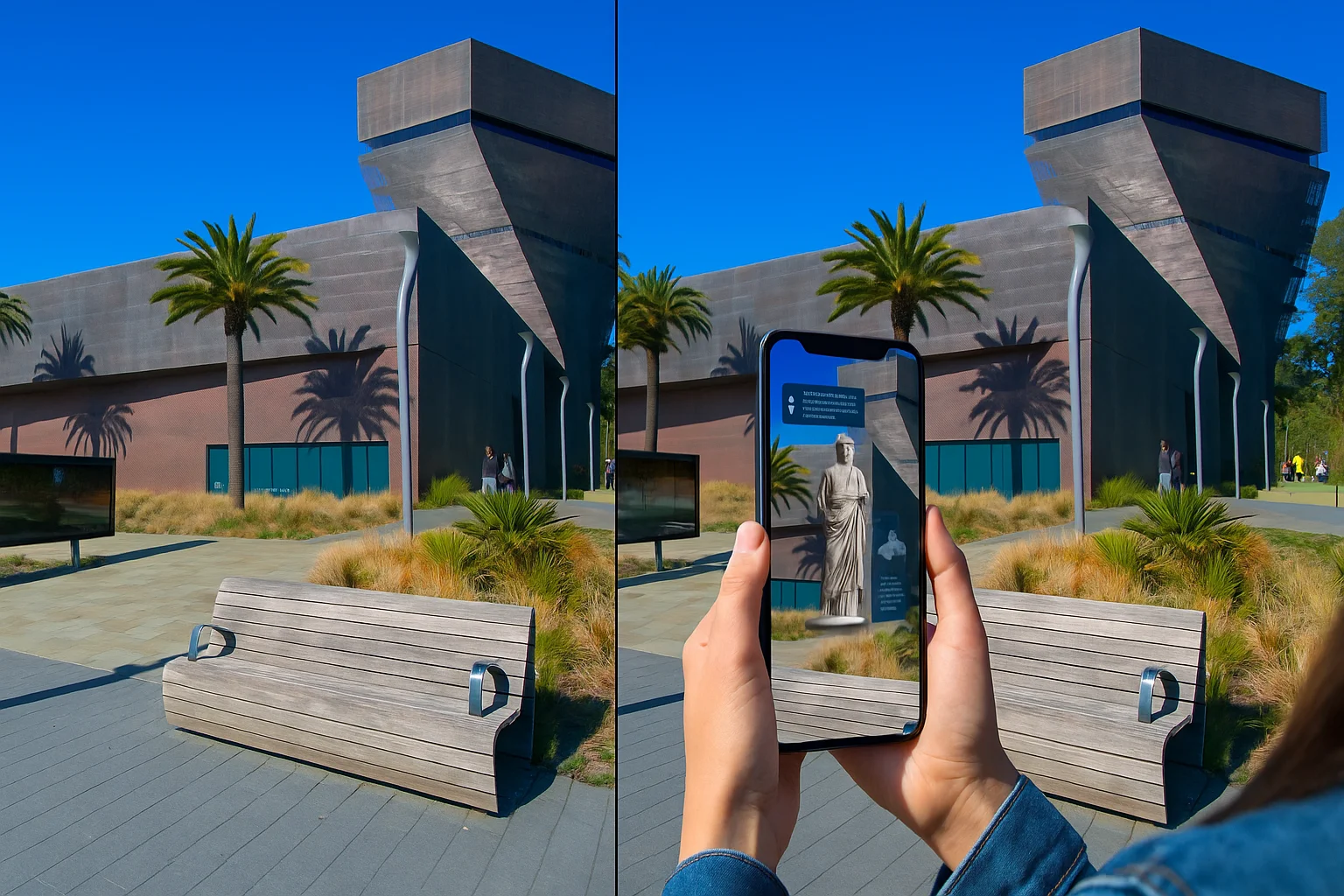
As part of its commitment to immersive learning, de Young plans to use AR to deliver guided digital overlay, virtual reconstructions, and layer interpretive approaches to its various fine art and history exhibitions.
Most notable museums, such as the Smithsonian, National Gallery, and National Museum of Singapore, are incorporating AR in order to bring exhibits to life, enhance learning, and create an engaging experience with more contemporary users.
Benefits of AR for Museum Storytelling
Applying AR to telling stories in museums creates amazing new opportunities:
Makes characters and history come alive
Tourists can listen to the voices, observe animations, and touch the virtual recreation of individuals who made history.
Improves emotional connection
Guests do not merely read facts, but get to feel the context: the everyday life, issues, and worldview of underrepresented groups in particular.
Layer stories without cluttering the space
AR provides the capability to add video, voice, and imagery, without consuming physical space or altering vulnerable exhibits.
Fits various styles of learning
AR may provide the details in the form of reading, listening, and visual interfacing to a visitor who might desire to read, listen more, or see more.
Storytelling should be accessible to everyone
AR can also accommodate a variety of audiences with subtitles, adaptive interfaces, or multilingual support, and expand accessibility.
Increases customer retention and participation
Experiential efforts are more memorable- people are likely to recall the tales they experienced and not those they have read.
Encourages deeper exploration
Visitors are able to select what they wish to get to know further, and this creates individualistic learning experiences and satisfaction.
Top Ways to Use AR in Your Museum
As a curator, an educator, or an exhibit designer, you do not need to add AR to become overwhelmed. As a matter of fact, it has the potential to open up a whole new style of interacting with your visitors, without having to increase the physical space.
These are the real examples of creative solutions to utilizing AR in museums nowadays:
Bring World-Famous Artworks to Your Museum
Unable to buy an actual Monet or Greek sculpture? No problem. AR enables you to show precise 3D replicas of some famous works not only in your country but in the whole world, and beginners can investigate details, textures, and backgrounds without even delving into the world outside your gallery.
Use Virtual Layers to Tell Stories
AR can give your displays some extra dimensions! Tourists will be able to scan an object to get access to the layers of historical context, interviews with the artists, animated reenactments, or a translation into a native language. It changes the passive consumption into sought-out discovery.
Empower Museum Guides with AR Tools
Provide your educators with tablets or AR glasses that will produce animations, diagrams, or virtual timelines in real time. This makes group tours more powerful and provides the best storytelling tools that could suit any audience.
Let AR Highlight Your Museum’s Niche
Are you preoccupied with space, dinosaurs, fashion, or folk tales? An AR experience can be themed to your preference. Re-create rituals, re-play the past in interactive 3D and 2D images, re-hand of historical clothing, and simulate a rocket launch.
Create a Virtual Portal for the Museum
Not all people are able to come in person. Through AR web-based systems, individuals are in a position to access curated virtual tours, 3D models, as well as educational overlays, regardless of their location. It brings you to an international level, an ideal target audience in schools or as a fan base overseas.
Add Magic Mirrors and Smart Displays
Put up interactive mirrors that will allow visitors to put themselves into historical outfits, turn into historical characters, or observe the exhibits of another period. They are particularly popular in children, science, and fashion museums.
Sell AR Merchandise
Provide postcards, prints, or T-shirts that spring to life when scanned. In another example, how about a video of a Roman soldier describing how to use a souvenir Roman helmet to play the role of a memory builder rather than giving a mere gift?
Want to bring your museum to life with immersive storytelling and innovative AR tech?
🎯 Hire Our AR Developer and turn your exhibits into unforgettable experiences.
Creating Impactful AR Experiences in Museums
It is not a question of adding some shiny technology; it is about applying AR efficiently.
To develop really meaningful AR experiences in museums, one should keep emphasizing storytelling, connection with visitors, and accessibility. AR should not be a distraction from the heart of the exhibit. Properly implemented, it enhances emotional appeal, creates a sense of mystery, and transforms a passive visitor into an active participant.
Here is what an AR museum will become most memorable:
Begin with the narrative of the technology
It is not managed to impress people through animation but rather to present to people a story that would stir their hearts. The AR should be based on you and your story.
Make it natural and smooth
Apple products should not be the ones that require tech manuals to use. Uncomplicated scans, uncluttered graphics, and clear directions are easily sufficient.
Employ the perspectives by deploying 3D, audio, and motion3
Don’t just think of visual overlays. Engage more of the senses by adding voiceover, background noise, or fixing a movement.
Incorporate the Voices and ideas of different people
Tell the stories that are forgotten, the stories you won’t hear every day, the stories about marginalized people, and cultural details.
Do not make it mandatory: make it optional.
Certain visitors are fond of technology. Some of them like conventional exhibitions. The actual AR experiences adhere to these two ways and allow users to select how they want to proceed.
Put to the test with actual people
To test your AR, find families, students, and seniors to test. They will tell what is and is not working through their feedback.
AR as a mission-driven and empathetically designed layer brings a museum into the present-day reality, but it also makes it more humane.
EuphoriaXR’s Latest AR in Museum’s Case Study: Virginia Beach Historic Houses

Project Overview
EuphoriaXR (in collaboration with Virginia Beach History Museums (VBHM)) has launched an AR experience in historic buildings such as the Francis Land House and Princess Anne County Training School as part of the 2023 Historic Houses Interpretive Plan. The aim is to increase visitor participation with immersive storytelling that would not have been possible with conventional exhibits.
Mission & Vision
Mission: Provide the VBHM initiative of the engagement of the citizens and visitors via the creation of meaningful arts, heritage, and cultural experiences through the use of AR as a means of connecting and learning.
Vision: Give visitors opportunities to understand history, not read about it, by entering re-created scenes, varied stories, and changing architecture.
Objectives & Goals
Relate the community narratives of Indigenous descent with the current society
Give more airtime to minorities (slaves, laborers, and underserved citizens)
Make daily life situations with a 3D AR overlay (e.g., preparing food, school, etc.)
Demonstrate the architecture with the stages of building reconstruction
Relate local history to national, indicating a wider influence in society
AR content was created in collaboration with planners, historians, and community stakeholders with the implementation of visitor-centered storytelling, which creates an educational, entertaining, and empathetic experience. The video presents examples of how the partnership between Virginia Beach History Museums and EuphoriaXR makes use of Augmented Reality (AR) to transform the methods of local storytelling in such places as Francis Land House and Princess Anne County Training School. Watch the full experience here:
The significance of this cannot be overstated because the body can only retain practically half of one percent of the information in it. The rest is examined and exorcized.
Why It Matters?
In this sense, this project demonstrates a tactical renovation in the museum interpretation. We cannot keep using AR when using it just because it is a trendy and trendy thing, as it is intentional to expand representation, effect, and make history more accessible to all audiences.
Risks and Challenges of AR in Museums
However, as much as the possibilities of AR are tremendous, obstacles also exist. To deliver a hitch-free experience, the museums should prepare with the following:
Not Everyone Has the Right Device
Not all visitors are likely to have smartphones, or it can be that they may not be comfortable using the phenomenon of smartphones while visiting a museum. This may restrict the people who access the AR experience.
Too Much Tech Can Be Distracting
When every exhibit is flashing images, soundtracks, and movable objects, it will be too much. AR must not compete but add to the tangible piece of art or artifact.
Costs Can Add Up
Developing and sustaining the AR content is a time and money-consuming process. You will require developers, fresh software, and constant support to ensure that everything is running fine.
Not Everyone Learns the Same Way
Children can adore it. Astounded adults who are capable of using technology may be astonished. However, not all visitors will be familiar with it, particularly the elderly or someone with limited access to digital means, who may be confused or even annoyed.
Technology Isn’t Always Reliable
It can be spoiled by problems, slow loading, low internet connection, etc. The museums have to take care of a good Wi-Fi connection, build offline-friendly apps, and constantly test the system.
What’s Next for AR in Museums?
The future of AR in museums can turn out to be the most intuitive, personified, and accessible ever before. That is what lies ahead:
WebAR will be the standard: Visitors will no longer be required to download an app. Visitors will use mobile browsers where using a simple QR code will run WebAR experiences.
Personalization with artificial intelligence: The AR content will change according to the interests of the visitor dynamically. AR will create the journey for a person, whether he/she is fond of antique or modern design.
Virtual tour guides and holograms: Digital avatars will soon provide you with a much more interactive and human experience, being capable of giving tours, answering questions, and even re-enacting historical events.
Worldwide access to the local collections: AR will enable the museums to bring local exhibits to people across the world. Lifelong learners, educators, and students will be in a better position to study rare artifacts wherever they are.
Gamified experiences aimed at younger children and families: Gamified experiences designed to entertain children and families, including more AR scavenger hunts, story-driven quests, and learning games, are on the rise.
Greater inclusiveness and interactivity in storytelling: AR will ensure sharing of varied voices, the cultural lens, and underrepresented histories, making museums a promiscuous and learning experience for one and all.
This technology will continue to expand, and AR will not be a novelty; it will be a standard way for the museum to bind itself to the community through connection, education, and inspiration.
Make your museum out of stagnant exhibits. Discover how to attract your visitors to your museum, educate and inspire them better than ever with augmented reality.
Final Thoughts
The use of AR in museums is not a trend; it is a change.
It makes mums and dads and statues and books which are silent to talk, grey old papers into exciting journeys, and history which is miles and miles away turn into something you can hold in your hand. Although there are problems to be solved, the advantages are too strong to overlook.
As technology becomes more mainstream, AR will enter into a standardized set of modern museum experience tools with access between education and engagement, and expeditions.
Whether you are a museum professional, a teacher, or a curious visitor, one issue can be stated with no doubt: the future of learning is interactive. And it is already here.

